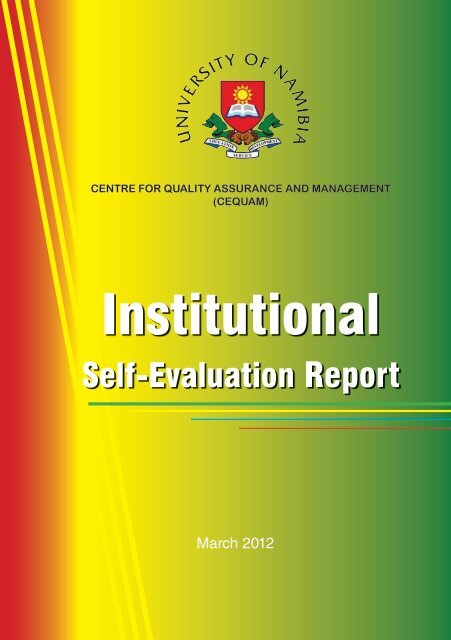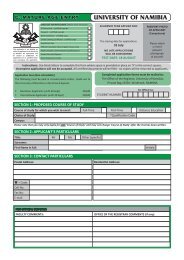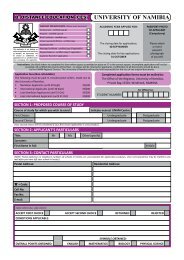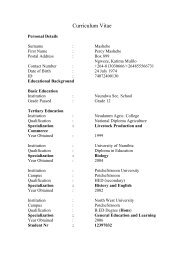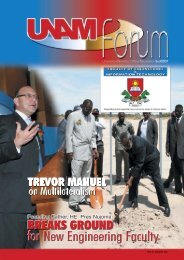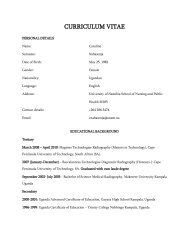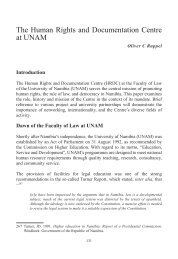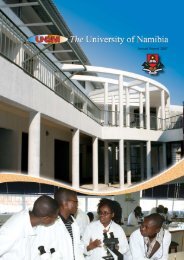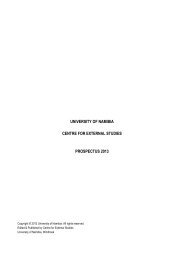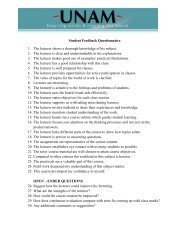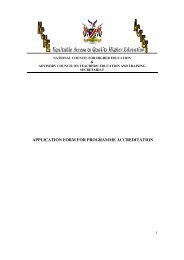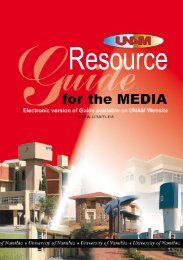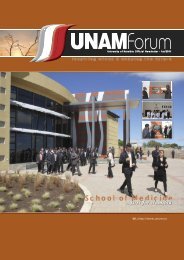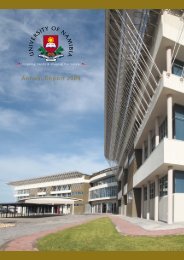Institutional Self-Evaluation Report - University of Namibia
Institutional Self-Evaluation Report - University of Namibia
Institutional Self-Evaluation Report - University of Namibia
You also want an ePaper? Increase the reach of your titles
YUMPU automatically turns print PDFs into web optimized ePapers that Google loves.
CENTRE FOR QUALITY ASSURANCE AND MANAGEMENT<br />
(CEQUAM)<br />
<strong>Institutional</strong><br />
<strong>Self</strong>-<strong>Evaluation</strong> <strong>Report</strong><br />
March 2012
<strong>Institutional</strong> <strong>Self</strong>-<strong>Evaluation</strong> <strong>Report</strong><br />
<strong>Self</strong>-<strong>Evaluation</strong> Panel: Ms. Y. Dausab, Chairperson<br />
Mr. C. Mabhiza (Group 1 coordinator)<br />
Mr. R. Izaks (Group 2 coordinator)<br />
Dr. A. Ogunmokum (Group 3 coordinator)<br />
Mr. B. Kaurivi (Group 4 coordinator)<br />
Dr. F.S. Nyathi<br />
Dr. M. Mostert<br />
Mr. A. Fledersbacher<br />
Ms. J. Aipanda<br />
Mr. E. Tjiramba<br />
Dr. E. Maass<br />
Mr. K. Mbangu<br />
Mr. N. Kadhila<br />
Mr. R. van Rooi<br />
Mrs. I. van Wyk<br />
Ms. H. Taapopi<br />
_______________________<br />
Pr<strong>of</strong>. Lazarus Hangula<br />
Vice-Chancellor: <strong>University</strong> <strong>of</strong> <strong>Namibia</strong><br />
March 2012
1. INTRODUCTION........................................................................................................... 7<br />
1.1 The <strong>Self</strong>-<strong>Evaluation</strong> Process .................................................................................... 7<br />
1.2 The <strong>Self</strong>-<strong>Evaluation</strong> Focus........................................................................................ 8<br />
1.3 Data Collection........................................................................................................ 8<br />
1.4 Positive aspects and challenges encountered.......................................................... 9<br />
1.4.1 Positive aspects.................................................................................................... 9<br />
1.4.2 Challenges............................................................................................................ 9<br />
2. INSTITUTIONAL CONTEXT........................................................................................... 10<br />
3. INSTITUTIONAL VISION, MISSION, GOALS AND OBJECTIVES: (What is the<br />
institution trying to do?)....................................................................... 12<br />
3.1 Mission.................................................................................................................. 12<br />
3.2 Vision..................................................................................................................... 12<br />
3.3 Mandate................................................................................................................. 13<br />
3.4 Strategic plan........................................................................................................ 13<br />
3.5 Strategic Objectives............................................................................................... 13<br />
4. GOVERNANCE AND GENERAL MANAGEMENT, AND MANDATED ACTIVITIES:<br />
(How is the institution trying to do it?)......................................................... 16<br />
4.1 GOVERNANCE AND GENERAL MANAGEMENT........................................................... 16<br />
4.1.1 Governance......................................................................................................... 16<br />
4.1.2 Administration.................................................................................................... 16<br />
4.1.2.1 Central Administration: Office <strong>of</strong> the Vice Chancellor....................................... 16<br />
4.1.2.2 Office <strong>of</strong> the PVC: Academic Affairs and Research........................................... 17<br />
4.1.2.3 Office <strong>of</strong> the PVC: Administration and Finance................................................. 17<br />
4.2 HUMAN RESOURCES MANAGEMENT SYSTEM......................................................... 18<br />
4.3 FINANCIAL RESOURCES MANAGEMENT SYSTEM..................................................... 19<br />
4.4 INFRASTRUCTURE AND LEARNING RESOURCES ..................................................... 20<br />
4.5 LIBRARY SERVICES ............................................................................................... 22<br />
4.6 INSTITUTIONAL INFORMATION................................................................................. 23<br />
4.7 CURRICULUM PLANNING, DESIGN AND DEVELOPMENT........................................... 24<br />
4.8 TEACHING AND LEARNING ..................................................................................... 25
4.8.1 Teaching and learning.........................................................................................25<br />
4.8.2 Assessment <strong>of</strong> students...................................................................................... 26<br />
4.9 STUDENT SUPPORT AND PROGRESSION ................................................................. 27<br />
4.10 RESEARCH, DEVELOPMENT AND EXTENSION.........................................................27<br />
4.11 COMMUNITY ENGAGEMENT AND CONSULTANCY ................................................... 28<br />
4.11.1 Community engagement................................................................................... 28<br />
4.11.2 Consultancy.......................................................................................................29<br />
4.12 STAKEHOLDERS RELATIONS ................................................................................. 30<br />
4.13 INTERNATIONALISATION ....................................................................................... 30<br />
5. INTERNAL QUALITY ASSURANCE MANAGEMENT SYSTEM:<br />
How does the institution know it works?.............................................. 32<br />
6. STRATEGIC MANAGEMENT AND CAPACITY TO CHANGE:<br />
How does the institution change in order to improve?......................... 34<br />
7. CONCLUSION............................................................................................................ 35<br />
7.1 Strengths............................................................................................................... 35<br />
7.2 Areas needing improvement................................................................................... 37<br />
7.3 Action plan............................................................................................................ 38<br />
8. APPENDICES............................................................................................................. 42
1. INTRODUCTION<br />
This report is the result <strong>of</strong> an <strong>Institutional</strong> <strong>Self</strong>-<strong>Evaluation</strong> process<br />
<strong>of</strong> the <strong>University</strong> <strong>of</strong> <strong>Namibia</strong> (UNAM), undertaken in August 2011 in<br />
preparation for an external evaluation by Europe-Africa Quality Connect<br />
from September 2011 to February 2012. Four key questions based on a<br />
‘fitness for and <strong>of</strong> purpose’ guided the evaluation, namely:<br />
• What is the <strong>University</strong> trying to do?<br />
• How is the <strong>University</strong> trying to do it?<br />
• How does it know it works?<br />
• How does the <strong>University</strong> change in order to improve?<br />
1.1 The <strong>Self</strong>-<strong>Evaluation</strong> Process<br />
The self-evaluation process was undertaken by a panel appointed by<br />
the Vice-Chancellor, comprising <strong>of</strong> 15 members from the <strong>University</strong> <strong>of</strong><br />
<strong>Namibia</strong> community. The self-<strong>Evaluation</strong> Panel comprised <strong>of</strong> the following<br />
members: Ms. Y. Dausab – Senior Lecturer in the Faculty <strong>of</strong> Law; Dr. F.S.<br />
Nyathi - Quality Assurance Director; Dr. M. Mostert - Senior Lecturer in<br />
the Faculty <strong>of</strong> Education; Mr. A. Fledersbacher – Registrar; Mr. B. Kaurivi<br />
– Lecturer in the Language Centre; Mr. C. Mabhiza – Senior Librarian; Mr.<br />
E. Tjiramba – Director for Marketing and Communication; Dr. E. Maass -<br />
Director <strong>of</strong> Academic Affairs; Mr. K. Mbangu – Director for Strategic and<br />
Physical Planning; Mr. N. Kadhila – Quality Assurance Coordinator; Mr. R.<br />
Izaks – Human Resources Director; Mr. R. van Rooi – Assistant Bursar;<br />
Mrs. I. van Wyk – Assistant Director for Estate Services; Ms. H. Taapopi –<br />
Student Representative Council: Academic Affairs; Dr. A. Ogunmokum –<br />
Deputy Dean for the Faculty <strong>of</strong> Engineering and Information Technology;<br />
and Ms. J. Aipanda – Administrative <strong>of</strong>ficer for the Quality Assurance<br />
Department.<br />
<strong>Institutional</strong> <strong>Self</strong>-<strong>Evaluation</strong> <strong>Report</strong><br />
7
Mrs. A. Kamati, a lecturer at Oshakati Campus also assisted with<br />
data collection at Ogongo Campus, Oshakati Campus, the Faculty <strong>of</strong><br />
Engineering and IT Campus, and Hifikepunye Pohamba Campus.<br />
Ms. Y. Dausab was the Chairperson was responsible for overseeing and<br />
leading the coordination <strong>of</strong> the <strong>Self</strong>-<strong>Evaluation</strong> process. The Centre for<br />
Quality Assurance and Management (CEQUAM) held the administrative<br />
and logistics responsibilities. The <strong>Self</strong>-<strong>Evaluation</strong> Panel divided itself<br />
into four groups, each with a coordinator. Each group was allocated four<br />
themes in which they collected data.<br />
1.2 The <strong>Self</strong>-<strong>Evaluation</strong> Focus<br />
The self-evaluation was conducted on various aspects <strong>of</strong> the <strong>University</strong>’s<br />
mandated activities, namely: institutional vision, mission, goals and<br />
objectives; governance and general management; institutional quality<br />
assurance management system; strategic planning; human resources<br />
management system; financial resources management system;<br />
infrastructure and learning resources; library services; institutional<br />
information; curriculum planning, design and development; teaching<br />
and learning; student support and progression; research, development<br />
and extension; community engagement; stakeholders relation; and<br />
internationalization.<br />
1.3 Data Collection<br />
The data was collected through interviews with various members <strong>of</strong><br />
the <strong>University</strong> community that included the Vice-Chancellor, Pro-Vice<br />
Chancellor for Academic Affairs and Research, Pro-Vice-Chancellor for<br />
Administration and Finance, Deans <strong>of</strong> faculties, Directors <strong>of</strong> various units,<br />
Academic Heads <strong>of</strong> Departments, other academic and administrative<br />
staff at all UNAM campuses. Students were also involved in the self<br />
evaluation process both as representatives on the <strong>Self</strong>-<strong>Evaluation</strong> Panel<br />
and as respondents. Where possible, interviews were conducted through<br />
focus-group discussions and where it was difficult to bring the people<br />
together in respective units; individuals were interviewed at a time<br />
convenient to them.<br />
8 <strong>Institutional</strong> <strong>Self</strong>-<strong>Evaluation</strong> <strong>Report</strong>
Information generated during the data collection exercise was then<br />
analysed and used to compile this report.<br />
1.4 Positive aspects and challenges encountered<br />
The <strong>Self</strong>-<strong>Evaluation</strong> Exercise presented both opportunities and<br />
challenges.<br />
1.4.1 Positive aspects<br />
The whole exercise was supported and graced by the senior management<br />
<strong>of</strong> the <strong>University</strong>. All Participants acknowledged that the process was<br />
enlightening and informative and expressed hope that it would bring<br />
about improvement and long-awaited change.<br />
1.4.2 Challenges<br />
One <strong>of</strong> the challenges experienced was time constraint. <strong>Self</strong>-evaluation<br />
requires an investment <strong>of</strong> time and the time that was available to the<br />
<strong>University</strong>’s disposal to do a thorough <strong>Self</strong>-<strong>Evaluation</strong> was not sufficient.<br />
It was very difficult to synchronize the <strong>Self</strong>-<strong>Evaluation</strong> activities with<br />
the already-in-place <strong>University</strong> calendar. It was, therefore, very difficult<br />
to bring members <strong>of</strong> different constituencies <strong>of</strong> the <strong>University</strong> together<br />
so that they participate in the data collection process as respondents.<br />
Most <strong>of</strong> the members <strong>of</strong> the <strong>Self</strong>-<strong>Evaluation</strong> team also found it difficult<br />
to be present at all <strong>Self</strong>-<strong>Evaluation</strong> activities. Other members <strong>of</strong> the<br />
<strong>Self</strong>-<strong>Evaluation</strong> team that were available had to work under pressure to<br />
complete and submit the report on time.<br />
The other challenge was a lack <strong>of</strong> cooperation from some <strong>of</strong> the academic<br />
and administrative staff as not everyone understood and supported the<br />
idea <strong>of</strong> evaluation. Interviewers also encountered challenges in soliciting<br />
data that portrayed weaknesses in a given component.<br />
<strong>Institutional</strong> <strong>Self</strong>-<strong>Evaluation</strong> <strong>Report</strong><br />
9
2. INSTITUTIONAL CONTEXT<br />
The <strong>University</strong> <strong>of</strong> <strong>Namibia</strong> (UNAM) is an autonomous institution <strong>of</strong> higher<br />
learning that was established by an Act <strong>of</strong> Parliament on August 31, 1992<br />
(<strong>University</strong> <strong>of</strong> <strong>Namibia</strong> Act 18 <strong>of</strong> 1992). In accordance with the National<br />
Development Plans (NDP 1&2), Vision 2030, and indeed informed by its<br />
motto: “Education, Service, Development”, the <strong>University</strong>’s programmes<br />
are designed to meet national human resource requirements through<br />
quality teaching, research, consultancy and community service. In the<br />
same vein the <strong>University</strong> endeavors to create knowledge and contribute<br />
to the growth <strong>of</strong> the economy through research.<br />
The <strong>University</strong> <strong>of</strong> <strong>Namibia</strong> <strong>of</strong>fers diverse academic programmes at<br />
undergraduate and post graduate levels delivered by its eight faculties<br />
namely;<br />
• Faculty <strong>of</strong> Agriculture and Natural Resources;<br />
• Faculty <strong>of</strong> Economics and Management Sciences;<br />
• Faculty <strong>of</strong> Education;<br />
• Faculty <strong>of</strong> Humanities and Social Sciences;<br />
• Faculty <strong>of</strong> Law;<br />
• Faculty <strong>of</strong> Medical and Health Sciences (comprising <strong>of</strong> the School <strong>of</strong><br />
Medicine and School <strong>of</strong> Nursing and Public Health);<br />
• Faculty <strong>of</strong> Science; and<br />
• Faculty <strong>of</strong> Engineering and Information Technology (IT).<br />
To meet the educational needs <strong>of</strong> a diverse <strong>Namibia</strong>, UNAM has<br />
11 campuses and eight regional centers countrywide. The latter are<br />
managed by the Centre for External Studies (CES), the distance and<br />
life-long education unit <strong>of</strong> the <strong>University</strong>.<br />
The 11 campuses are:<br />
• Windhoek Main Campus<br />
10 <strong>Institutional</strong> <strong>Self</strong>-<strong>Evaluation</strong> <strong>Report</strong>
• Katima Mulilo Campus<br />
• Khomasdal Campus<br />
• Neudamm Campus<br />
• Ogongo Campus<br />
• Hifikepunye Pohamba Campus<br />
• Ongwediva Engineering and IT Campus<br />
• Oshakati Campus<br />
• Rundu Campus<br />
• School <strong>of</strong> Medicine Campus<br />
• Henties Bay Sam Nujoma Marine and Coastal Resources Research<br />
Centre (SANUMARC)<br />
The <strong>University</strong> serves the nation in various ways and contributes<br />
significantly to nation building and development. The <strong>University</strong> <strong>of</strong><br />
<strong>Namibia</strong> strives to ensure that it is acknowledged as a higher institution<br />
<strong>of</strong> choice for students as well as a sought after reservoir <strong>of</strong> expertise for<br />
business and industry both locally and internationally. The <strong>University</strong> has<br />
over 15 000 students, 122 PhD holders, 36 Pr<strong>of</strong>essors, 288 lecturers<br />
(Master’s degree holders). It <strong>of</strong>fers 36 undergraduate degrees, 19<br />
Master’s degrees, and 12 doctoral degrees (PhDs).<br />
Quality assurance activities <strong>of</strong> the <strong>University</strong> <strong>of</strong> <strong>Namibia</strong> are regulated<br />
by its own Quality Assurance policy as well as the National Council<br />
for Higher Education’s (NCHE) National Quality Assurance System for<br />
Higher Education. Its programmes are in line with the requirements <strong>of</strong><br />
the <strong>Namibia</strong> Qualification Authority’s (NQA) National Qualifications<br />
Framework (NQF), which also plays a part in the maintenance <strong>of</strong> the<br />
university’s Quality through, among others, institutional accreditation.<br />
In terms <strong>of</strong> the current challenges facing the <strong>University</strong>, budgetary<br />
constraints are the key issues that have a great impact on the<br />
institutional operations and quality <strong>of</strong> service delivery. The institution has<br />
observed a drastic increase in student enrolments while funding from the<br />
Government has been shrinking, especially in the absence <strong>of</strong> a proper<br />
funding formula.<br />
<strong>Institutional</strong> <strong>Self</strong>-<strong>Evaluation</strong> <strong>Report</strong><br />
11
3. INSTITUTIONAL VISION, MISSION, GOALS AND<br />
OBJECTIVES: (What is the institution trying to do?)<br />
Quality assessment and self-analysis have to start by looking at the<br />
formulated mission and vision statements, the formulated goals and<br />
aims, as well as the formulated expected outcomes.<br />
3.1 Mission<br />
The mission <strong>of</strong> the <strong>University</strong> <strong>of</strong> <strong>Namibia</strong> is “to provide Quality Higher<br />
education through teaching, research and advisory services to our<br />
customers with the view to produce productive and competitive human<br />
resources capable <strong>of</strong> driving public and private institutions towards a<br />
knowledge-based economy, economic growth and improved quality <strong>of</strong><br />
life.”<br />
3.2 Vision<br />
The vision <strong>of</strong> the <strong>University</strong> <strong>of</strong> <strong>Namibia</strong> is “to be a beacon <strong>of</strong> excellence<br />
and innovation in teaching, research and extension services.”<br />
The <strong>University</strong>’s mission and vision statements are clearly articulated,<br />
and are in line with the national strategic development goals and the<br />
latest international trends in higher education. The strategic objectives<br />
are also clearly articulated and are in line with the institution’s Mission<br />
and Vision.<br />
It was, however, observed that although the mission and vision statements<br />
were readily available on the UNAM website, strategic plan documents<br />
and other institutional materials are not known and appreciated by<br />
everybody (staff and students). On UNAM’s campuses not everybody<br />
(staff and students) knows and appreciate these.<br />
12 <strong>Institutional</strong> <strong>Self</strong>-<strong>Evaluation</strong> <strong>Report</strong>
The suggested plan <strong>of</strong> action includes the displaying <strong>of</strong> Vision and<br />
Mission statements at strategic positions by the Directorate <strong>of</strong> Marketing<br />
and Communication at all campuses. This would include educating the<br />
stakeholders on the same. It is also recommended that the Directorate <strong>of</strong><br />
Physical and Strategic Planning finalize the implementation <strong>of</strong> electronic<br />
monitoring and evaluation system.<br />
3.3 Mandate<br />
The mandate <strong>of</strong> UNAM as stipulated in its enabling legislation (<strong>University</strong><br />
<strong>of</strong> <strong>Namibia</strong> Act 18 <strong>of</strong> 1992) is “to provide higher education, undertake<br />
research, advance and disseminate knowledge, provide extension<br />
services, encourage the growth and nurturing <strong>of</strong> cultural expression<br />
within <strong>Namibia</strong>, to further training and continuing education, contribute to<br />
social and economic development <strong>of</strong> <strong>Namibia</strong>, and to foster relationships<br />
with any person or institution both nationally and internationally.”<br />
Based on the findings <strong>of</strong> this review, UNAM believes that it is fulfilling<br />
this mandate. It is, however, suggested that there is a need for the<br />
Directorate <strong>of</strong> Marketing and Communication to develop and implement<br />
formal mechanisms for soliciting feedback from various stakeholders to<br />
substantiate this claim.<br />
3.4 Strategic plan<br />
The <strong>University</strong> <strong>of</strong> <strong>Namibia</strong> has translated its Mission and Vision into a clear<br />
Strategic Plan where the mission statement has been operationalized in<br />
achievable goals and objectives. This is evident on UNAM’s current Five<br />
Years Strategic Plan (2011-2015), which was approved by Council and<br />
is now being implemented. Different units and faculties have developed<br />
their divisional-based One Year Management Plans based on this<br />
Strategic Plan. Some <strong>of</strong> the respondents, however, felt that that the<br />
mission statement is too long and needed to be shortened.<br />
3.5 Strategic Objectives<br />
The strategic objectives as outlined in the current Five Year Strategic<br />
<strong>Institutional</strong> <strong>Self</strong>-<strong>Evaluation</strong> <strong>Report</strong><br />
13
Plan (2011-2015) are as follows:<br />
• Improve relevance <strong>of</strong> programmes<br />
• Improve quality <strong>of</strong> programmes<br />
• Improve student and staff welfare<br />
• Improve equitable access for students and staff<br />
• Improve quality <strong>of</strong> teaching and learning<br />
• Increased research output<br />
• Enhance community engagement<br />
• Improve registration process<br />
• Diversify dissemination <strong>of</strong> knowledge<br />
• Improve the delivery <strong>of</strong> quality extension services<br />
• Strengthen international liaison and collaboration<br />
• Optimize resource mobilization management<br />
• Improve the corporate image<br />
• Improve quality <strong>of</strong> library services<br />
• Improve organizational culture<br />
• Expand internal physical facilities<br />
• Improve quality <strong>of</strong> academic, operational and support services<br />
• Improve efficiency and effectiveness <strong>of</strong> examination systems<br />
• Improve effectiveness and maintenance <strong>of</strong> all physical facilities<br />
• Strengthen records management and archives administration<br />
• Strengthen human capacity management<br />
• Develop and implement best practice knowledge creation<br />
• Improve ICT infrastructure and usage<br />
• Diversify and increase sources <strong>of</strong> revenue sources<br />
• Improve financial management<br />
• Promote Corporate governance<br />
The strategic objectives are very clear and they set the goals for what<br />
the institution intends to do for the next five years. The current strategic<br />
plan is, however, very new. It is, therefore, not possible to tell at this<br />
stage whether the institution is achieving these objectives or not. The<br />
formalized quality assurance system is also relatively new and quality<br />
14 <strong>Institutional</strong> <strong>Self</strong>-<strong>Evaluation</strong> <strong>Report</strong>
assurance at this stage has not been used as a tool for strategic planning<br />
as there is a lack <strong>of</strong> feedback.<br />
The Directorate <strong>of</strong> Physical and Strategic Planning has developed a<br />
monitoring and evaluation framework (MEF) for the implementation <strong>of</strong><br />
the Strategic Plan and Management action Plans. The Directorate also<br />
started with business/performance review meetings this year to monitor<br />
and evaluate the implementation <strong>of</strong> Management Plans. It was reported<br />
that the institution is in its third strategic plan but it is only beginning to<br />
implement the system for monitoring and evaluation <strong>of</strong> the implementation<br />
<strong>of</strong> the strategic plan. The implementation <strong>of</strong> this system is, however, at<br />
the initial stage and its effectiveness might take some time before its<br />
impact can be assessed. Attainment <strong>of</strong> objectives will only be assessed<br />
by year end.<br />
It is suggested that the Directorate <strong>of</strong> Physical and Strategic Planning<br />
finalize the implementation <strong>of</strong> the MEF, and use quality assurance<br />
mechanisms as a tool for future strategic planning.<br />
<strong>Institutional</strong> <strong>Self</strong>-<strong>Evaluation</strong> <strong>Report</strong><br />
15
4. GOVERNANCE AND GENERAL MANAGEMENT,<br />
AND MANDATED ACTIVITIES: (How is the institution<br />
trying to do it?)<br />
4.1 GOVERNANCE AND GENERAL MANAGEMENT<br />
The governance structure <strong>of</strong> the <strong>University</strong> <strong>of</strong> <strong>Namibia</strong> must be clear<br />
and adequate. The institution must have a clear management structure<br />
in which the decision-making process, competencies and responsibilities<br />
are clearly defined and reflected.<br />
4.1.1 Governance<br />
The Council <strong>of</strong> the <strong>University</strong> <strong>of</strong> <strong>Namibia</strong> is responsible for the<br />
governance <strong>of</strong> the institution and also serves as its executive authority.<br />
The organization and superintendence <strong>of</strong> instruction, examinations,<br />
lectures, classes, curricula and research are vested in the Senate <strong>of</strong> the<br />
<strong>University</strong>.<br />
4.1.2 Administration<br />
Administration at the <strong>University</strong> <strong>of</strong> <strong>Namibia</strong> is patterned on the<br />
Commonwealth model. The Chancellor serves as the titular head <strong>of</strong><br />
the <strong>University</strong> while the Vice Chancellor as Chief Executive Officer is<br />
responsible for the day-to-day management <strong>of</strong> the <strong>University</strong>.<br />
4.1.2.1 Central Administration: Office <strong>of</strong> the Vice Chancellor<br />
The Office <strong>of</strong> the Vice Chancellor (VC) comprises <strong>of</strong> the Vice Chancellor<br />
Pr<strong>of</strong>. Lazarus Hangula who is assisted by the Pro-Vice Chancellor for<br />
Academic Affairs & Research (PVC: AA&R) Pr<strong>of</strong>. Osmund Mwandemele<br />
and the Pro-Vice Chancellor for Administration and Finance (PVC: A&F)<br />
Dr. Boniface Mutumba.<br />
16 <strong>Institutional</strong> <strong>Self</strong>-<strong>Evaluation</strong> <strong>Report</strong>
4.1.2.2 Office <strong>of</strong> the PVC: Academic Affairs and Research<br />
This <strong>of</strong>fice advises and assists the VC in academic research, consultancy<br />
matters, fostering standards <strong>of</strong> excellence in teaching and publication,<br />
as well as developing academic programmes and curricula which are<br />
responsive to the socio-economic development needs <strong>of</strong> <strong>Namibia</strong>, the<br />
SADC Region and Africa at large. The PVC: AA&R provides guidance<br />
and supervision to Deans <strong>of</strong> Faculties, Directors <strong>of</strong> Academic Centres as<br />
well as the <strong>University</strong> Librarian and the Office <strong>of</strong> the Registrar.<br />
4.1.2.3 Office <strong>of</strong> the PVC: Administration and Finance<br />
This is the Chief Adviser to the VC in administration, management and<br />
financial matters. He is tasked to ensure that UNAM attains maximum<br />
efficiency, enhanced cost effectiveness and high quality delivery in terms<br />
<strong>of</strong> service to the <strong>University</strong> community and the public at large. In this<br />
regard the <strong>of</strong>fice is primarily assisted by the <strong>University</strong> Bursar, as well<br />
as the Directors <strong>of</strong> Communications and Marketing, Human Resources,<br />
Computer Centre, Estate Services, the Dean <strong>of</strong> Students and the Director<br />
<strong>of</strong> the <strong>University</strong> Foundation.<br />
The self-evaluation exercise established that the <strong>University</strong> <strong>of</strong> <strong>Namibia</strong>’s<br />
governance structure is clear and adequate. The governance structure is in<br />
line with the constitution <strong>of</strong> the <strong>University</strong> and international best practices<br />
such as the Commonwealth model. The <strong>University</strong> <strong>of</strong> <strong>Namibia</strong>’s structure<br />
comprises <strong>of</strong> a Chancellor, a Vice-Chancellor, Pro-Vice Chancellors<br />
(Academic Affairs & research, and Administration & Finance), a Council,<br />
a Senate, the academic and administrative staff, and students. Students<br />
and other stakeholders (internal and external) are well represented on<br />
the governance structures such as Council, Senate, various committees<br />
and boards.<br />
The management structure <strong>of</strong> the institution is also clearly defined.<br />
The decision-making process, competencies and responsibilities <strong>of</strong> the<br />
managers and other staff are also clearly defined.<br />
It would seem from interviews with various stakeholders that<br />
communication <strong>of</strong> decisions-made at higher levels such as Council,<br />
Senate, various committees and boards seems not to easily reach staff<br />
at lower level. There is need to improve communication <strong>of</strong> decisions<br />
<strong>Institutional</strong> <strong>Self</strong>-<strong>Evaluation</strong> <strong>Report</strong><br />
17
made to come to lower levels <strong>of</strong> staff members and follow up activities on<br />
higher decisions are also productive. It is hoped that the appointment <strong>of</strong><br />
the Director for Academic Affairs would make and follow-ups easier.<br />
In terms <strong>of</strong> striking a balance between centralization and decentralisation,<br />
it was felt that the intention for decentralisation is good but the<br />
implementation and effectiveness <strong>of</strong> this endeavor are worrisome.<br />
Centralisation means that the decision-making and control function are<br />
concentrated at the top management <strong>of</strong> the institution. Decentralisation<br />
means that the directors and deans have more freedom to make their<br />
own decisions about the operations <strong>of</strong> their units. Deans <strong>of</strong> faculties feel<br />
that they are not even involved in the hiring process <strong>of</strong> the new staff in<br />
their faculties. There is also a lack <strong>of</strong> autonomy at the satellite campuses.<br />
This function is entirely left to Human Resources. It is, however, noted that<br />
the decentralisation <strong>of</strong> examinations is a remarkable achievement. The<br />
suggested action plan is that there is a need to improve decentralisation<br />
<strong>of</strong> decision-making to enhance efficiency.<br />
4.2 HUMAN RESOURCES MANAGEMENT SYSTEM<br />
Human resources management system includes strategies, policies and<br />
arrangements for recruitment, appointments, record-keeping, labour<br />
relations, employment equity, performance management, compensation<br />
and benefits, and training and development.<br />
It emerged from the self-evaluation exercise that the management <strong>of</strong><br />
human resources <strong>of</strong> the <strong>University</strong> <strong>of</strong> <strong>Namibia</strong> is conducted within an<br />
approved framework <strong>of</strong> institutional strategies, policies and arrangements<br />
for acquiring, developing and utilizing sufficient numbers <strong>of</strong> qualified and<br />
experienced academic and support staff.<br />
The <strong>University</strong> has mechanisms in place to ensure that hiring,<br />
administration and training <strong>of</strong> their teaching and administrative/support<br />
staff is carried out with the necessary guarantees to ensure that they can<br />
fulfill their corresponding functions.<br />
There are mechanisms in place for take care <strong>of</strong> high-quality faculty<br />
staff and support staff by clearly defining their responsibilities, and by<br />
18 <strong>Institutional</strong> <strong>Self</strong>-<strong>Evaluation</strong> <strong>Report</strong>
evaluating their performance on an annual basis and by means <strong>of</strong> an<br />
adequate staff appraisal system. There is, however, a concern on the<br />
effectiveness <strong>of</strong> the staff appraisal system. One <strong>of</strong> the respondents<br />
claimed that “staff appraisals are done every year but no one follows<br />
up on these to give feedback on performance”. There was, therefore, a<br />
suggestion that there should be an improvement in the use <strong>of</strong> the staff<br />
appraisal system.<br />
There is also a programme <strong>of</strong> staff development that assists academic<br />
staff to upgrade their qualifications and enhance their knowledge and<br />
skills in the fields relevant to their duties. It is felt that the staff development<br />
programme <strong>of</strong> the institution is excellent and it is one <strong>of</strong> the best practices<br />
in the region. Many <strong>of</strong> the academic and administrative staff went through<br />
and are undergoing this system to obtain their Master’s degrees and PhDs.<br />
Administrative staff, however, reported that there is no formal system<br />
for staff development for administrative/support staff. There is also no<br />
appraisal system for support staff. Training for administrative staff is only<br />
recommended on case by case when gaps are observed. It is, therefore,<br />
suggested that the institution should formalise the staff development<br />
programme for administrative staff and implement an appraisal system<br />
for support staff if there is any.<br />
It is also reported that the induction programme for new staff members<br />
is not adequate as most <strong>of</strong> the staff members did not go through such<br />
a programme on commencement <strong>of</strong> their service at the <strong>University</strong>. The<br />
suggested action plan is that the Human Resources Directorate needs to<br />
improve on the induction programme for new staff.<br />
4.3 FINANCIAL RESOURCES MANAGEMENT SYSTEM<br />
The financial management system includes strategies, policies and<br />
arrangements for budgeting, resource allocation, asset management,<br />
debt management and financial reporting.<br />
It was reported during the self-evaluation exercise that the management<br />
<strong>of</strong> financial resources <strong>of</strong> the institution is conducted within an approved<br />
framework <strong>of</strong> institutional strategies, policies and arrangements to enable<br />
the institution meet its financial needs. The financial department carries<br />
<strong>Institutional</strong> <strong>Self</strong>-<strong>Evaluation</strong> <strong>Report</strong><br />
19
out internal and external audits.<br />
It was established that the Government provides funding to UNAM in<br />
order to meet its operational needs but this funding is never sufficient<br />
or not efficiently channelled to priority areas. The <strong>University</strong> receives<br />
budgetary support from the State as a block grant and then it allocates<br />
it to different units. Different divisions report that they always get far less<br />
than requested for their activities. They also claim that the budgeting<br />
process is not transparent as there is no consultation when the budget<br />
is prepared and decided on. Divisions are requested to submit their<br />
budgetary needs but decision makers seem not to look at these proposals<br />
when the government gives money to the institution. The budget is also<br />
not realistic for the needs and expectations <strong>of</strong> the current Strategic<br />
Plan in place. These divisions claim that this state <strong>of</strong> affairs hampers<br />
achievement <strong>of</strong> their goals.<br />
There is need to improve on institutional revenue mechanisms and<br />
financial allocation as well as decentralization <strong>of</strong> financial resources. The<br />
institution must also improve on alternative sources for funding instead<br />
<strong>of</strong> heavily relying on government funding.<br />
There is also a serious concern with regards to the time taken and the level<br />
<strong>of</strong> pr<strong>of</strong>essionalism in getting things through procurement. It is, therefore,<br />
suggested that the institution should introduce a computer-based system<br />
for tracking requisitions and staff members in financial department should<br />
improve on their pr<strong>of</strong>essionalism and customer relations.<br />
4.4 INFRASTRUCTURE AND LEARNING RESOURCES<br />
The facilities management system includes strategies, policies and<br />
arrangements for facilities planning and acquisitions, the direction for<br />
design and construction activities, maintenance <strong>of</strong> buildings, grounds<br />
and equipment, space assignment and utilization, and real estate<br />
management.<br />
The management <strong>of</strong> facilities <strong>of</strong> the institution is not conducted within<br />
an approved framework as there is no policy on facility management<br />
system in place. The <strong>University</strong> has a transport policy, which is under<br />
20 <strong>Institutional</strong> <strong>Self</strong>-<strong>Evaluation</strong> <strong>Report</strong>
eview. The recommendation for action plan is that the Estate Services<br />
Directorate develops a comprehensive policy for maintenance and capital<br />
development to improve the practice.<br />
It was also established that the institutional facilities at some <strong>of</strong> the<br />
campuses that include the Main Campus such as the School <strong>of</strong> Medicine<br />
and the Faculty <strong>of</strong> Engineering and IT are modernized, up-to-date, and<br />
suitable for their use although they are not adequate. Other campuses<br />
reported that their facilities are neither suitable nor adequate. Fixed chairs<br />
in most <strong>of</strong> the lecture halls are not suitable for teaching and learning<br />
interaction. Some <strong>of</strong> the lecture rooms are not yet fitted with multimedia<br />
facilities, smart boards, etc. The carrying capacity <strong>of</strong> most <strong>of</strong> the facilities<br />
has been exceeded by the increasing number <strong>of</strong> students. Student<br />
numbers increase yearly but facilities remain the same. This state <strong>of</strong><br />
affairs is reported to be worse at the recently integrated formal colleges<br />
<strong>of</strong> education. Some departments on the Main Campus also reported lack<br />
<strong>of</strong> laboratories and <strong>of</strong>fice space.<br />
Lack <strong>of</strong> lecture halls, <strong>of</strong>fice space, space in the library and shortage <strong>of</strong><br />
photocopy machines (a few which are available are normally out <strong>of</strong> order)<br />
were added on the list <strong>of</strong> complaints. Students reported a lack <strong>of</strong> leisure<br />
centers at all campuses. Most <strong>of</strong> the staff members and students alike<br />
were also unhappy with the removal <strong>of</strong> the swimming pool at the main<br />
campus. It became apparent that social welfare issues are given the least<br />
priority by the decision-makers. It was also reported that new campuses<br />
at UNAM such as Hifikepunye Pohamba Campus, Rundu Campus and<br />
Katima Mulilo Campus have a serious shortage <strong>of</strong> classrooms and<br />
lecture halls and auditoriums, as well as videoconference facilities. It is,<br />
therefore, suggested that there is a need to improve facilities at all <strong>of</strong> the<br />
university campuses including facilities <strong>of</strong> the Centre for External Studies<br />
(CES).<br />
Consistent complaints by students and lecturers were that the manual<br />
registration process is cumbersome, frustrating and wastes a lot <strong>of</strong> time<br />
at the beginning <strong>of</strong> the year. It was also reported that the registration<br />
process as a whole is in disarray, very customer unfriendly by some<br />
Faculty Officers as well as outdated. It was then suggested that there<br />
is an urgent need to finalize the implementation <strong>of</strong> on-line registration.<br />
<strong>Institutional</strong> <strong>Self</strong>-<strong>Evaluation</strong> <strong>Report</strong><br />
21
It is strongly recommended that the university explores the viability <strong>of</strong><br />
extending and upgrading the American designed Millennium System<br />
run by the library for online registration.<br />
It was also reported that maintenance is one <strong>of</strong> the most overlooked<br />
activities as there is a lack <strong>of</strong> maintenance <strong>of</strong> facilities at all campuses.<br />
It was reported that there are broken toilets and chairs, fused bulbs,<br />
leaking ro<strong>of</strong>s, malfunctioning smart boards and multimedia facilities etc.<br />
One <strong>of</strong> the respondents claimed that “there are no sufficient toilets and<br />
staff have to queue up with students”. There is need for improvement and<br />
regular maintenance <strong>of</strong> facilities.<br />
It was also suggested that UNAM improves the standard <strong>of</strong> facilities at<br />
all campuses to ensure that suitability and adequacy at all campuses. It<br />
is also suggested that there is a need for urgent upgrade <strong>of</strong> facilities at<br />
the formal colleges so that they are brought on par with the rest <strong>of</strong> the<br />
campuses.<br />
There was a need to develop and implement a system for monitoring and<br />
evaluation <strong>of</strong> the management <strong>of</strong> facilities, infrastructure and learning<br />
resources.<br />
4.5 LIBRARY SERVICES<br />
The <strong>University</strong> <strong>of</strong> <strong>Namibia</strong> has library facilities at all its campuses country<br />
wide (except at the Faculty <strong>of</strong> Engineering & IT and former teaching<br />
colleges which recently merged with the <strong>University</strong>) to support teaching<br />
and learning with very supportive library staff. It is reported that library<br />
books in most disciplines as well as the time allocated to borrowers<br />
are sufficient. There is, however, a lack <strong>of</strong> specialized journals in some<br />
disciplines such as law and Geology. However, some students felt that<br />
some <strong>of</strong> the books in the library were outdated and it takes time to acquire<br />
new ones. Academics also reported that it was very difficult to access<br />
e-journals. The library reports that this problem lies with the server and<br />
bandwidth which are the responsibility <strong>of</strong> the Computer Centre. It is,<br />
therefore, suggested that the Computer Centre suggests a solution to<br />
this problem.<br />
22 <strong>Institutional</strong> <strong>Self</strong>-<strong>Evaluation</strong> <strong>Report</strong>
Library users reported that space in all library branches is limited, while<br />
typing facilities and allocation <strong>of</strong> hours per computer were not sufficiently.<br />
The problem <strong>of</strong> poor quality library services is reported to be worse at<br />
Hifikepunye Pohamba Campus, Rundu Campus and Katima Mulilo<br />
Campus as these campuses are new to UNAM. It is suggested that the<br />
library should improve space, computer facilities and allocation <strong>of</strong> time<br />
per computer, and update library resources such as books, journals, IT<br />
facilities, etc. at all campuses, especially the campuses that are new to<br />
UNAM.<br />
The library reported that they have mechanisms to regularly evaluate the<br />
adequacy and accessibility <strong>of</strong> resources and services for students and<br />
staff through user surveys. There is, however, need to improve on taking<br />
appropriate remedial measures to address inadequacies and customer<br />
dissatisfaction.<br />
4.6 INSTITUTIONAL INFORMATION<br />
The <strong>Institutional</strong> Information Division normally answers all <strong>University</strong><br />
related information requests and provides the necessary institutional<br />
insight for decision making on all levels <strong>of</strong> management. It undertakes<br />
institutional research, generates information reports on issues such<br />
as enrolment rates, dropouts, graduation rates, etc., and handles<br />
ad hoc institutional information requests from internal and external<br />
stakeholders.<br />
<strong>Institutional</strong> information has been identified as one <strong>of</strong> the weakest links<br />
<strong>of</strong> the institution. It emanated from the self-evaluation exercise that the<br />
institution does not have a centralized system in place or a dedicated<br />
<strong>of</strong>fice that must collect and analyse institutional information that could<br />
be used for effective management <strong>of</strong> programmes <strong>of</strong> study and to inform<br />
decision-making. The <strong>University</strong> has taken an initiative to create a position<br />
for a statistician in the Directorate <strong>of</strong> Physical and strategic Planning but<br />
it is felt that the duties <strong>of</strong> the statistician are narrow and not well defined<br />
to cater for the need for institutional information. Additionally the level and<br />
duties accorded the current satisfaction are far below the conventional<br />
<strong>Institutional</strong> <strong>Self</strong>-<strong>Evaluation</strong> <strong>Report</strong><br />
23
credentials required for a <strong>University</strong> <strong>Institutional</strong> Researcher (at least a<br />
PhD).<br />
The action plan suggested is that there is a need to re-define the duties<br />
<strong>of</strong> the statistician to include the duties <strong>of</strong> institutional researcher or to<br />
create a dedicated institutional information <strong>of</strong>fice, and the duties and<br />
responsibilities <strong>of</strong> this person or <strong>of</strong>fice must be clearly defined and<br />
benchmarked with similar <strong>of</strong>fices in the region and beyond.<br />
4.7 CURRICULUM PLANNING, DESIGN AND DEVELOPMENT<br />
The <strong>University</strong> <strong>of</strong> <strong>Namibia</strong> has formal mechanisms for the approval,<br />
periodic review and monitoring <strong>of</strong> its programmes and awards. Academic<br />
programmes are in line with the Mission and Vision <strong>of</strong> the institution as<br />
well as national development priorities, and the learning outcomes are<br />
clearly formulated although some need improvement. New programmes<br />
are generated from departments and go through various approval stages<br />
which are Faculty Board, Academic Planning Committee, and then<br />
Senate. Senate-approved programmes are also submitted to the <strong>Namibia</strong><br />
Qualifications Authority (NQA) for NQF registration. It is, however,<br />
reported there is no policy on curriculum design and development but<br />
there is a documented strategy and procedures to be followed. It is,<br />
therefore, suggested that there is need to develop a policy on curriculum<br />
development and review, and consolidate all guidelines in one document,<br />
which must be widely disseminated. There is also a need for a curriculum<br />
review manual that can provide consistency in reviewing curriculum.<br />
Academic programmes are reviewed after every four years to ensure that<br />
they remain current, coherent, and up-to-date. Stakeholder consultations<br />
are carried out during new programme development or review to ensure<br />
that the programmes <strong>of</strong>fered meet the expectations <strong>of</strong> the stakeholders.<br />
There is, however, a concern that the four years cycle <strong>of</strong> curriculum review<br />
is rigid and does not provide for fast changing disciplines such as IT.<br />
There is need to implement a flexible review cycle to accommodate the<br />
fast changing programmes due to changes in demand and technology.<br />
There was also a concern as to whether the programmes <strong>of</strong> study met<br />
their goals and objectives in the absence <strong>of</strong> tracer studies to substantiate<br />
24 <strong>Institutional</strong> <strong>Self</strong>-<strong>Evaluation</strong> <strong>Report</strong>
the claims. It was, therefore, suggested that the institution needed to<br />
engage in regular tracer studies.<br />
It was reported that some <strong>of</strong> the faculties incorporate experiential learning<br />
in their programmes but it was difficult to find places for attachment <strong>of</strong><br />
students. It was suggested that there was need to improve on coordination<br />
<strong>of</strong> students’ placement and relationship or network with industry. Such<br />
an example can be emulated from the Faculty <strong>of</strong> Law that has a campusbased<br />
legal clinic at which students apply theory into practice.<br />
4.8 TEACHING AND LEARNING<br />
4.8.1 Teaching and learning<br />
The teaching and learning planning system includes strategies, policies<br />
and arrangements for development and approval <strong>of</strong> new programmes;<br />
programme review; development and approval <strong>of</strong> academic partnership;<br />
development and approval <strong>of</strong> short courses; effective and reliable central<br />
management <strong>of</strong> information on the institution’s academic <strong>of</strong>ferings.<br />
Teaching and learning are the core activities <strong>of</strong> the <strong>University</strong> <strong>of</strong> <strong>Namibia</strong>.<br />
The workload formula provides for 60% teaching time, 30% research<br />
time, and 10% community engagement time. The practice <strong>of</strong> teaching is,<br />
however, not based on any policy, as the <strong>University</strong> currently does not<br />
have in place an approved teaching and learning policy. Progress has,<br />
however, been made in the development <strong>of</strong> the Teaching and Learning<br />
Improvement Unit (TLIU). It is, therefore, suggested that the TLIU should<br />
finalize and implement the teaching and learning policy as a matter <strong>of</strong><br />
urgency.<br />
The <strong>University</strong> has a system in place for soliciting feedback from students<br />
on their experiences <strong>of</strong> teaching and courses through lecture evaluation<br />
by students. Students, however, report that this system is not transparent<br />
and effective as it does not provide feedback to students about the course<br />
and teaching improvement as well as the follow-up activities. Students<br />
revealed that they raised a number <strong>of</strong> issues with regards to the quality <strong>of</strong><br />
teaching but they saw no improvement. They recommended improvement<br />
on the student-lecturer evaluation system, feedback and transparency <strong>of</strong><br />
<strong>Institutional</strong> <strong>Self</strong>-<strong>Evaluation</strong> <strong>Report</strong><br />
25
this exercise.<br />
It was also reported that procedures for postgraduate studies are properly<br />
documented and every postgraduate programme passes through the<br />
Postgraduate studies Committee (PGSC). Supervision for postgraduate<br />
students is, however, perceived to unsatisfactory. It is suggested that the<br />
quality <strong>of</strong> supervision for postgraduate students be improved. There is<br />
also a need for a monitoring system for postgraduate studies. It is hoped<br />
that the establishment <strong>of</strong> the School <strong>of</strong> Postgraduate Studies will bring<br />
about improvement.<br />
When it comes to teaching methods, it was reported that lecturers<br />
do not use a variety <strong>of</strong> methods and student-centred approach is the<br />
least used. Teaching is heavily based on lecture methods. One <strong>of</strong> the<br />
respondents puts it as follows: “Interaction is mainly in the practical<br />
sessions but in theory sessions it is more <strong>of</strong> lecture style”. It was also<br />
reported that there is a serious lecturer’s misconception <strong>of</strong> what studentcentred<br />
approach entails. Most <strong>of</strong> the lecturers’ interpret this as giving<br />
student work to do and disappear from classes without playing a role<br />
<strong>of</strong> facilitators. The suggested action is to improve on the use <strong>of</strong> various<br />
teaching methods including student-centred approach. Worth noting is<br />
the fact that the university has no well-defined and widely disseminated<br />
teaching philosophy or strategy.<br />
4.8.2 Assessment <strong>of</strong> students<br />
The system for assessment <strong>of</strong> student learning includes strategies, policies<br />
and arrangements for regulations and procedures related to student<br />
assessment, including, for example, the security <strong>of</strong> test and examination<br />
papers, composition and calculation <strong>of</strong> marks, supplementary/special<br />
assessment opportunities, disciplinary and appeal procedures, internal<br />
and external moderation and examinations, etc.<br />
Assessment <strong>of</strong> students at the <strong>University</strong> <strong>of</strong> <strong>Namibia</strong> is done using<br />
published criteria, rules, regulations and procedures. There is, however,<br />
no overall assessment policy in place.<br />
It was suggested that the institution clearly define its assessment<br />
philosophy. This should be explicit and available to a wide audience. It<br />
26 <strong>Institutional</strong> <strong>Self</strong>-<strong>Evaluation</strong> <strong>Report</strong>
was also suggested that the TLIU strengthen the training workshops for<br />
academic staff on teaching and assessment methodologies.<br />
4.9 STUDENT SUPPORT AND PROGRESSION<br />
Support services include strategies, policies and arrangements for<br />
academic development services geared towards the enhancement <strong>of</strong><br />
academic skills, student counselling services, access to information and<br />
learning materials through efficient library services and ITC to enable<br />
students to achieve their learning objectives.<br />
The interviews revealed that the <strong>University</strong> <strong>of</strong> <strong>Namibia</strong> provides efficient<br />
and sufficient academic support services geared towards ensuring the<br />
quality <strong>of</strong> the academic outcomes and enhancing student success. It<br />
was also reported that health facilities, and guidance and counselling<br />
services were adequate and staff were qualified and experienced to<br />
carry out their duties. There is, however, need to develop and implement<br />
a social welfare policy that aims at enhancing the quality <strong>of</strong> student life.<br />
The implementation <strong>of</strong> this policy must be monitored and evaluated with<br />
reference to international best practices.<br />
It was observed that the <strong>University</strong> did not have adequate facilities for<br />
sports and recreation, catering services and hostels for students at all<br />
campuses. There was also a lack <strong>of</strong> campus-based social workers at<br />
satellite campuses. The main campus had 1000 hostel places available<br />
but needs at least 3000 more. It is hoped that facilities being constructed<br />
through public private partnership would ease the burden at the main<br />
campuses.<br />
It was suggested that existing student support services be improved and<br />
strengthened.<br />
4.10 RESEARCH, DEVELOPMENT AND EXTENSION<br />
The research management system includes strategies, policies and<br />
arrangements providing for shared understanding <strong>of</strong> the nature, role and<br />
goals <strong>of</strong> research at the institution.<br />
<strong>Institutional</strong> <strong>Self</strong>-<strong>Evaluation</strong> <strong>Report</strong><br />
27
The management <strong>of</strong> the institution’s research is conducted within an<br />
approved framework <strong>of</strong> institutional strategy. The institution also has<br />
in place a research and publications committee. There is, however, no<br />
institutional research policy in place on which the strategy and other<br />
arrangements must be based. It is suggested that development and<br />
implementation <strong>of</strong> an overall research policy for the institution be done.<br />
The Faculty <strong>of</strong> Agriculture and Natural Resources (FANR), and Faculty <strong>of</strong><br />
Humanities and Social Sciences (FHSS) were identified as examples <strong>of</strong><br />
best practices for having research agendas in place and setting research<br />
priorities for a given timeframe. It is suggested that different faculties and<br />
departments emulate these examples and develop research agendas for<br />
their faculties and departments.<br />
The institution also does not have in place a policy on Intellectual Property<br />
Rights (PIR). Although the current research strategy and the UCCB<br />
consultancy policy both have sections on PIR and a policy on plagiarism,<br />
there is need for the university to develop a stand-alone policy on PIR.<br />
It was also reported that the institution did not have a code <strong>of</strong> conduct for<br />
research in conjunction with the research unit including code <strong>of</strong> ethics.<br />
There is, therefore, a need for the Postgraduate Studies Committee to<br />
develop such a policy.<br />
Although the workload policy allots 30% <strong>of</strong> academic time to research,<br />
academic staff felt that this was not effectively done as they were overloaded<br />
with teaching loads and had little time left for research activities, which<br />
negatively affects research output. One <strong>of</strong> the respondents reported that<br />
“in theory the balance is fine but in practice staff academic members<br />
spend too much time on teaching and too little time or no time at all on<br />
research”. The suggested action plan is to find strategies to increase<br />
research output.<br />
4.11 COMMUNITY ENGAGEMENT AND CONSULTANCY<br />
4.11.1 Community engagement<br />
The community engagement management system includes strategies,<br />
policies and arrangements providing for a shared understanding <strong>of</strong> the<br />
28 <strong>Institutional</strong> <strong>Self</strong>-<strong>Evaluation</strong> <strong>Report</strong>
nature, role and goals <strong>of</strong> community engagement by the institution.<br />
It is always being said that the quality and impact <strong>of</strong> community<br />
engagement activities depend heavily on the satisfaction <strong>of</strong> those served<br />
and whether their interaction with the <strong>University</strong> causes and supports<br />
change in desirable ways. It was, however, reported that the management<br />
<strong>of</strong> the institution’s community engagement activities was not conducted<br />
within an approved framework <strong>of</strong> institutional strategies, policies and<br />
arrangements as there was no relevant policy or strategy in place.<br />
Although the workload policy allowed 10% <strong>of</strong> academic time to community<br />
engagement, it was not clear what community engagement entails and<br />
how both staff and students should undertake it. It is, therefore, suggested<br />
that the HR Directorate and Marketing and Communication Directorate<br />
to develop a policy and strategy on community engagement to guide<br />
the practice. The current state <strong>of</strong> affairs is that community engagement<br />
activities are done on an ad hoc basis. There are currently scattered<br />
reports on community engagement in UNAM Forum, <strong>University</strong> Central<br />
Consultancy Bureau (UCCB) and the Multidisciplinary Research Centre<br />
(MRC) but these are not properly documented. There is a need for the<br />
Marketing and Communication Directorate to improve documentation <strong>of</strong><br />
community engagement and produce half yearly community engagement<br />
reports. It is, therefore, suggested that coordination <strong>of</strong> community<br />
engagement activities needs to be centralized though the establishment<br />
<strong>of</strong> a community engagement <strong>of</strong>fice to support the implementation <strong>of</strong> the<br />
community engagement to centrally coordinate community engagement<br />
activities and monitor the implementation <strong>of</strong> the suggested policy and<br />
strategy.<br />
4.11.2 Consultancy<br />
The <strong>University</strong> <strong>of</strong> <strong>Namibia</strong> has a <strong>University</strong> Bureau for Central<br />
Consultancy (UCCB) with a business wing to generate revenue through<br />
consultancy. There is evidence <strong>of</strong> institutional contribution to the society<br />
and community through consultancies, through MRC and UCCB. It<br />
emanated that UCCB operated within a framework <strong>of</strong> an approved policy<br />
on consultancy. There is, however, a need to develop and implement<br />
mechanisms for monitoring and implementation <strong>of</strong> the consultancy policy<br />
and strategy.<br />
<strong>Institutional</strong> <strong>Self</strong>-<strong>Evaluation</strong> <strong>Report</strong><br />
29
4.12 STAKEHOLDERS RELATIONS<br />
The <strong>University</strong> <strong>of</strong> <strong>Namibia</strong> keeps its relationship with internal and<br />
external stakeholders through the Marketing and Communication<br />
Directorate as well as the newly established Directorate for External and<br />
Internal Relations. Stakeholders are consulted to give their inputs during<br />
programme development and curriculum reviews. Apart from having<br />
a system for soliciting feedback from students on their experiences <strong>of</strong><br />
teaching and learning and courses (teachers feedback), the <strong>University</strong><br />
did not have formal mechanisms in place for obtaining feedback from<br />
other stakeholders such as employers and others about the quality <strong>of</strong> its<br />
graduates and services.<br />
It is, therefore, suggested that the university develops and implement<br />
mechanisms to regularly undertake stakeholders’ surveys (alumni,<br />
employers, etc.) and use the findings from these surveys to improve the<br />
quality <strong>of</strong> teaching and learning, research, community service, and other<br />
service provision.<br />
4.13 INTERNATIONALISATION<br />
Internationalisation is one aspect that has gained increasing visibility<br />
among universities’ strategic priorities, with many institutions striving to<br />
attain greater internationalisation through training and research activities.<br />
Growing mobility among students and staff has become a central issue<br />
for many universities all over the world.<br />
The <strong>University</strong> <strong>of</strong> <strong>Namibia</strong> has recently established a Directorate for<br />
External and Internal Relations. This <strong>of</strong>fice is responsible for liaising with<br />
stakeholders. Since the <strong>of</strong>fice is relatively new, there was no policy or<br />
strategy document, which guides and defines external stakeholders, and<br />
how to choose and work with them. The <strong>University</strong> is, however, doing<br />
well in terms <strong>of</strong> forging links with reputable higher education institutions<br />
internationally. It was, however, felt that the staff and student exchange<br />
programme needed improvement. As one <strong>of</strong> the respondents put it,<br />
“student and staff exchange programme is one sided. We receive so<br />
many academic (sic) and students from other institutions in the world<br />
but we send very few probably due to funding problems”. It is, therefore,<br />
30 <strong>Institutional</strong> <strong>Self</strong>-<strong>Evaluation</strong> <strong>Report</strong>
suggested that the Directorate <strong>of</strong> external and internal Relations<br />
develop and implement a policy and strategy on stakeholder relations.<br />
The other suggestion is to strengthen/consolidate working relations/<br />
agreements. There is also need to develop mechanisms for monitoring<br />
and implementation <strong>of</strong> this policy and strategy. The other suggested<br />
action plan was to strength and improve student and staff exchange<br />
programmes.<br />
<strong>Institutional</strong> <strong>Self</strong>-<strong>Evaluation</strong> <strong>Report</strong><br />
31
5. INTERNAL QUALITY ASSURANCE<br />
MANAGEMENT SYSTEM: How does the institution<br />
know it works?<br />
The <strong>University</strong> <strong>of</strong> <strong>Namibia</strong> implemented a formalized internal quality<br />
assurance management system with a view to maintain, continuously<br />
monitor and improve the quality <strong>of</strong> its mandated activities. This system<br />
is, however, very recent as it was only introduced in January 2010 with<br />
the establishment <strong>of</strong> the Centre for Quality Assurance and Management<br />
(CEQUAM). The <strong>University</strong>-wide quality assurance policy was approved<br />
by Senate in June <strong>of</strong> the same year. There are also departmental selfevaluation<br />
guidelines and a quality assurance manual that was developed<br />
by CEQUAM.<br />
Most <strong>of</strong> the students that were interviewed reported that they did not<br />
know much about the existence <strong>of</strong> the quality assurance system and<br />
CEQUAM. They suggested that CEQUAM strengthened awareness<br />
over its existence and mission as well as improve on the promotion<br />
<strong>of</strong> a quality culture. Some staff members said they were aware <strong>of</strong> the<br />
existence <strong>of</strong> the Quality Assurance Policy but called for the development<br />
and implementation <strong>of</strong> a quality assurance implementation strategy.<br />
The UNAM quality assurance policy as well as the National Quality<br />
Assurance System by NCHE expect institutions <strong>of</strong> higher education<br />
in <strong>Namibia</strong> to implement internal quality assurance based on regular<br />
self-evaluation, and subject themselves to external audits by reputable<br />
quality assurance agencies. The national system is, however, also very<br />
new and UNAM has never undergone an external audit. Departmental<br />
self reviews have only started this year and the impact <strong>of</strong> these reviews<br />
on the quality <strong>of</strong> the institution might take some time to be felt since<br />
quality assurance is a process.<br />
32 <strong>Institutional</strong> <strong>Self</strong>-<strong>Evaluation</strong> <strong>Report</strong>
Departmental reviews have just started now, which will lead to<br />
departmental self-improvement plans. There is no database as yet<br />
in place to monitor the implementation <strong>of</strong> departmental as well as<br />
institutional self-improvement plans.<br />
With regards to benchmarking, there are some Faculties and Departments<br />
that use benchmarks although this is done in isolation. There is a need<br />
for CEQUAM to formulate a document outlining the principles for good<br />
benchmarking activities, including an explanation <strong>of</strong> the concept itself.<br />
It is recommended that CEQUAM fully develops and implements the<br />
quality assurance management system. CEQUAM should also develop<br />
and implement a computerized database for monitoring and evaluation<br />
<strong>of</strong> the implementation <strong>of</strong> the institutional quality assurance system.<br />
<strong>Institutional</strong> <strong>Self</strong>-<strong>Evaluation</strong> <strong>Report</strong><br />
33
6. STRATEGIC MANAGEMENT AND CAPACITY TO<br />
CHANGE: How does the institution change in order to<br />
improve?<br />
The <strong>University</strong> <strong>of</strong> <strong>Namibia</strong> is serious about strategic development and<br />
quality improvement. One <strong>of</strong> the strategic initiatives that the university<br />
has taken is the implementation <strong>of</strong> the current Five Year Strategic<br />
Plan (2011 - 2015). Another initiative is the formalization <strong>of</strong> the Quality<br />
Assurance system through the establishment <strong>of</strong> the Centre for Quality<br />
Assurance and Management to support the implementation <strong>of</strong> the quality<br />
assurance policy. The fact that the <strong>University</strong> <strong>of</strong> <strong>Namibia</strong> is undertaking<br />
departmental reviews is an indication that the institution is committed to<br />
continuous improvement through strategic management.<br />
The other positive initiative for strategic management commitment <strong>of</strong> the<br />
institution is inviting Europe-Africa Quality Connect to review it so that it<br />
can learn from this exercise and benchmark its activities with the best<br />
practices in the world. The objective <strong>of</strong> this review is to enhance strategic<br />
development. <strong>Institutional</strong> reviews will enhance public confidence in the<br />
quality <strong>of</strong> education and training provided by UNAM and the standards<br />
<strong>of</strong> its qualifications/awards.<br />
The <strong>University</strong> <strong>of</strong> <strong>Namibia</strong> is, however, faced with many challenges that<br />
impact on quality. One <strong>of</strong> the challenges is increased student enrolments<br />
and shrinking carrying capacity <strong>of</strong> the infrastructure and facilities at all<br />
its campuses. The other major challenge is government funding which is<br />
never enough for the institution to fully implement its strategic plan. This<br />
is largely due to a lack <strong>of</strong> government funding formula.<br />
34 <strong>Institutional</strong> <strong>Self</strong>-<strong>Evaluation</strong> <strong>Report</strong>
7. CONCLUSION<br />
The institution, through the self-evaluation exercise, identified a number<br />
<strong>of</strong> strengths and areas needing improvement, and suggested plans <strong>of</strong><br />
action to bring about improvement.<br />
7.1 Strengths<br />
The institution identified its strengths in the following areas:<br />
• <strong>Institutional</strong> mission and vision are clearly articulated, and are in<br />
line with the national strategic development goals and the latest<br />
international trends in higher education.<br />
• The mission and vision statements have been translated into a clear<br />
Five Year Strategic Plan (2011 - 2015) where the mission statement is<br />
operationalized in achievable strategic goals.<br />
• Divisions have developed One Year Management Plans based on the<br />
Strategic Plan.<br />
• A monitoring and <strong>Evaluation</strong> Framework for the implementation <strong>of</strong> the<br />
strategic Plan as well as Management Plans has been developed and<br />
now being implemented.<br />
• The <strong>Institutional</strong> management structure is clear and adequate.<br />
• <strong>Institutional</strong> human resources management practices are conducted<br />
within an approved framework <strong>of</strong> institutional policies and arrangements<br />
for acquiring, developing and utilizing academic and administrative<br />
staff.<br />
• There is a system in place for academic staff appraisal.<br />
• There is an effective staff development programme in place.<br />
<strong>Institutional</strong> <strong>Self</strong>-<strong>Evaluation</strong> <strong>Report</strong><br />
35
• <strong>Institutional</strong> management <strong>of</strong> financial resources is conducted within<br />
an approved framework <strong>of</strong> institutional strategies, policies and<br />
arrangements to enable the institution to meet its financial needs.<br />
• Some campuses such as the School <strong>of</strong> Medicine, Faculty <strong>of</strong> Engineering<br />
and IT, and some divisions at the main campus have state-<strong>of</strong>-the art<br />
facilities.<br />
• The institution has libraries and library facilities at most <strong>of</strong> its campuses<br />
with very supportive staff.<br />
• The library has in place mechanisms to monitor and evaluate<br />
adequacy and accessibility <strong>of</strong> library resources and services through<br />
user surveys.<br />
• The <strong>University</strong> has in place formal mechanisms for approval, periodic<br />
review and monitoring <strong>of</strong> its programmes <strong>of</strong> study and awards.<br />
• Most <strong>of</strong> the programmes <strong>of</strong> study incorporate experiential learning to<br />
prepare students for the real world <strong>of</strong> work.<br />
• The university has a system in place for lecturer and course evaluation<br />
by students.<br />
• The university has taken a positive strategic initiative by establishing a<br />
School <strong>of</strong> Postgraduate Studies.<br />
• Students’ assessment is done using published criteria, rules and<br />
regulations.<br />
• The institution has in place a system for academic support services.<br />
• The institution has in place a research strategy as well as consultancy<br />
policy.<br />
• The institution has taken a positive strategic initiative by establishing a<br />
Directorate for External and Internal Relations.<br />
• The institution has a number <strong>of</strong> workable agreements with reputable<br />
institutions in the world.<br />
• The institution has taken a positive strategic initiative by establishing<br />
36 <strong>Institutional</strong> <strong>Self</strong>-<strong>Evaluation</strong> <strong>Report</strong>
a Centre for Quality Assurance and Management to support the<br />
implementation <strong>of</strong> the quality assurance system.<br />
7.2 Areas needing improvement<br />
The institution identified its limitations in the following areas:<br />
• Not everybody (staff and students) knows and appreciates the<br />
institutional mission and vision.<br />
• Top-down communication needs improvement.<br />
• Decentralization <strong>of</strong> activities and management need improvement.<br />
• Staff appraisal system needs improvement.<br />
• An induction programme for the new staff seems not to be adequate.<br />
• Lack <strong>of</strong> funding is a major hindrance in carrying out institutional<br />
mandated activities.<br />
• The institution does not have in place a policy on maintenance and<br />
capital development.<br />
• Facilities are inadequate and the carrying capacity <strong>of</strong> most <strong>of</strong> the<br />
facilities cannot cope with increasing numbers <strong>of</strong> students.<br />
• There is a lack <strong>of</strong> maintenance <strong>of</strong> existing facilities at all campuses.<br />
• There is a lack <strong>of</strong> library resources such as books, specialized journals,<br />
photocopy machines, printers, space, etc.<br />
• <strong>Institutional</strong> information is underdeveloped.<br />
• The institution does not have online registration.<br />
• The institution does not have a policy on curriculum design, development<br />
and review.<br />
• The institution does not have a policy on teaching and learning.<br />
• The institution does not have a policy on assessment.<br />
<strong>Institutional</strong> <strong>Self</strong>-<strong>Evaluation</strong> <strong>Report</strong><br />
37
• The system <strong>of</strong> lecturer and course evaluation by students needs<br />
improvement.<br />
• The quality <strong>of</strong> supervision at postgraduate level needs improvement.<br />
• The student-centred approach is least applied in teaching and learning,<br />
and most <strong>of</strong> the academics interviewed did not understand how it<br />
works.<br />
• There is no overarching philosophy for teaching that reflects whether<br />
instruction is premised on e.g. constructivism, pragmatism, etc.<br />
• The institution does not have a research policy.<br />
• The institution does not have a policy on Intellectual Property Right.<br />
• The institution does not have in place a code <strong>of</strong> conduct for research,<br />
including code <strong>of</strong> ethics.<br />
• The institution does not maintain a balance between teaching and<br />
research as spelt out in the workload policy, more weight is given to<br />
teaching.<br />
• The institution does not have a policy or strategy on community<br />
engagement.<br />
• The institution does not have formal mechanisms for obtaining<br />
feedback from different stakeholders to help improving the quality <strong>of</strong><br />
its <strong>of</strong>ferings and services.<br />
• The institution does not have an approved policy and strategy on<br />
stakeholder relations.<br />
• There are no formalized mechanisms for monitoring and evaluation in<br />
most <strong>of</strong> the institutional systems and processes.<br />
7.3 Action plan<br />
The institution suggests the following actions for improvement:<br />
• Improve the promotion <strong>of</strong> the mission and vision statements.<br />
38 <strong>Institutional</strong> <strong>Self</strong>-<strong>Evaluation</strong> <strong>Report</strong>
• Finalize the implementation <strong>of</strong> monitoring and evaluation strategy for<br />
the Strategic Plan.<br />
• Use quality assurance as a tool for strategic planning in future strategic<br />
plans.<br />
• Improve communication <strong>of</strong> decision-making and follow-ups.<br />
• Improve decentralization <strong>of</strong> decision-making to enhance efficiency.<br />
• Improve the staff appraisal system.<br />
• Improve staff development programme for support staff.<br />
• Implement an appraisal system for support staff.<br />
• Strengthen the induction programme for new staff.<br />
• Improve institutional revenue and financial allocation.<br />
• Implement alternative sources <strong>of</strong> funds.<br />
• Implement UMS.<br />
• Develop a policy on infrastructure and facility management.<br />
• Improve facilities at all campuses.<br />
• Improve regular maintenance <strong>of</strong> facilities.<br />
• Improve IT services.<br />
• Improve library services at all campuses.<br />
• Improve institutional information.<br />
• Develop a policy on curriculum planning, development and review.<br />
• Develop a teaching and learning as well as assessment philosophy.<br />
• Strengthen the training <strong>of</strong> academic staff on the latest teaching and<br />
assessment methodologies.<br />
• Finalise the implementation <strong>of</strong> online registration.<br />
Alternatively,<br />
<strong>Institutional</strong> <strong>Self</strong>-<strong>Evaluation</strong> <strong>Report</strong><br />
39
upgrade the American designed Millennium System for expedient and<br />
efficient student-registration<br />
• Subject some selected Faculty Officers to customer relations training<br />
as they tarnish the image <strong>of</strong> the institution through unfriendly behaviour<br />
during registration.<br />
• Improve student lecturer evaluation system.<br />
• Improve supervision at postgraduate studies level.<br />
• Improve on the use <strong>of</strong> student-centred approach.<br />
• Improve and strengthen the existing student support services.<br />
• Develop a research policy.<br />
• Revise/update the existing research strategy.<br />
• Develop institutional and faculty/departmental research agendas.<br />
• Develop a policy on Intellectual Property Rights.<br />
• Develop an institutional code <strong>of</strong> conduct for research, including code<br />
<strong>of</strong> ethics.<br />
• Increase research output.<br />
• Develop a policy on community engagement.<br />
• Improve coordination <strong>of</strong> community engagement activities.<br />
• Implement a formalized system for stakeholder feedback including<br />
surveys and tracer studies.<br />
• Develop a policy on stakeholder relations including<br />
internationalization.<br />
• Strengthen/consolidate the existing agreements with other higher<br />
education institutions.<br />
• Strengthen and improve student and staff exchange programmes,<br />
including joint programmes <strong>of</strong> study.<br />
40 <strong>Institutional</strong> <strong>Self</strong>-<strong>Evaluation</strong> <strong>Report</strong>
• Strengthen quality assurance awareness.<br />
• Improve the promotion <strong>of</strong> a culture <strong>of</strong> quality.<br />
• Develop a quality assurance implementation strategy.<br />
• Develop a document outlining the principles for good benchmarking,<br />
including an explanation <strong>of</strong> the concept itself.<br />
• Implement monitoring and evaluation systems in all mandated activities<br />
<strong>of</strong> the institution.<br />
<strong>Institutional</strong> <strong>Self</strong>-<strong>Evaluation</strong> <strong>Report</strong><br />
41
8. APPENDICES<br />
• Faculties prospectuses<br />
• General information and regulations<br />
• Map <strong>of</strong> <strong>Namibia</strong> showing all campuses and centres<br />
• Strategic Plan<br />
• Sample divisional Management Action Plans<br />
• Monitoring and <strong>Evaluation</strong> Framework (MEF)<br />
• Business/performance reviews reports<br />
• Governance structure/organogram<br />
• UNAM statutes/Act<br />
• UNAM calendar<br />
• Sample committees and boards meetings<br />
• Latest institutional organogram<br />
• Sample job descriptions?<br />
• HR policies<br />
• Staff appraisal forms and sample reports?<br />
• Statistics on staff members studied through staff development<br />
programme<br />
• Financial management related policies<br />
• Financial allocation from government<br />
42 <strong>Institutional</strong> <strong>Self</strong>-<strong>Evaluation</strong> <strong>Report</strong>
• Programme development and review strategy and guidelines<br />
• Sample minutes <strong>of</strong> stakeholder consultation meetings<br />
• Examinations rules and regulations (general information?)<br />
• Guidelines for postgraduate student and supervisors<br />
• Research agendas from FHSS & FANR<br />
• Plagiarism policy<br />
• Sample UCCB & MRC reports<br />
• UCCB consultancy policy<br />
• Sample library user survey reports<br />
• Quality assurance policy<br />
• <strong>Self</strong>-evaluation guidelines<br />
• Quality assurance manual<br />
• Sample MOUs<br />
<strong>Institutional</strong> <strong>Self</strong>-<strong>Evaluation</strong> <strong>Report</strong><br />
43
Center for Quality Assurance & Management (CEQUAM)<br />
Tel.: +264 61 206 4607 • Fax: +264 61 206 4573<br />
P/Bag 13301, Windhoek, <strong>Namibia</strong><br />
44 <strong>Institutional</strong> <strong>Self</strong>-<strong>Evaluation</strong> <strong>Report</strong>


